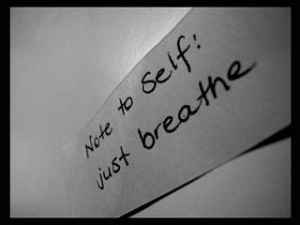Yoga, deep breathing and meditation continue to make strides in the healthcare industry. More specifically, deep breathing is now widely recognized for its’ “profound impact on our physiology and our health” says Mladen Golubic, a physician in the Cleveland Clinic’s Center for Integrative Medicine. Yet, the power of breath is still an unknown in our culture and within mainstream medicine.
Yogi’s understood the power of breath. In fact, postures (asana) were created to strengthen the body to sit for breathing (pranayama) and meditation. The breath is the most important aspect of the yoga tradition and one of the most important functions of the body in maintaining health.
The average American has 21,600 breaths every 24 hours (15 breaths per min X 60 min X 24 hours). The breathing process is the foundation of all brain function and 12 energy systems of the body. The respiratory system feeds our cardiovascular system and supports our digestive and lymphatic systems; two systems paramount to processing food and the removal of toxins and imbalances from the body. Breathing is also the only physiological function that can be controlled. Otherwise, it occurs involuntarily from the intelligence of the autonomic nervous system.
Yogi’s created various forms of breathing to control the breath and master the breathing process. Manipulating the breath facilitates various responses from the body. Depending on the pace and depth of the breath, the autonomic nervous system sends signals to the parasympathetic (rest and digest) or sympathetic (flight or flight) systems. The nervous system reacts to the breathing of the body every second whether awake or asleep. Rapid or shallow breathing strongly decreases parasympathic response. To increase the parasympathic response, less than 12 breaths per minute is required.
Keeping the nervous system in the parasympathetic response is crucial to physical and mental health and longevity to the average life span of the cellular body. Stress continues to be the # 1 factor in the top 10 diseases killing Americans today. Breathing plays a significant role in reducing stress and anxiety. The average American is living in the sympathetic system even while reading this article and considered in a “resting state”.
If you’d like to learn more about the powerful effects of breathing, join Ed Harrold for his 10-Day Breathe, Love, Live series. The FREE series begins December 9th.
Each day, Ed will email you a guided breathing class with education on how and why breathing is such a powerful tool within your yoga and meditation practice, for enhancing performance in athletics, reducing stress and anxiety and for alleviating symptoms of various disease states.
Breath is not bound by race, economic status or geography. It’s available to everyone and any time. So, breathe . . . You Are Alive!
 Wendy is the co-owner and Director of Center For Whole Self Health, in Wilmington, DE, and Co-owner and Director of Marketing for My Zen Home. Wendy has over 10 years within the Health & Wellness industry. Wendy’s background in Corporate America in the financial industry lends itself to understanding the demands and stresses of this environment. Her passion for living well combined with her background in business affords our clients wisdom with their wellness initiatives.
Wendy is the co-owner and Director of Center For Whole Self Health, in Wilmington, DE, and Co-owner and Director of Marketing for My Zen Home. Wendy has over 10 years within the Health & Wellness industry. Wendy’s background in Corporate America in the financial industry lends itself to understanding the demands and stresses of this environment. Her passion for living well combined with her background in business affords our clients wisdom with their wellness initiatives.


![0EAB8191-8D8A-4B03-959C-8AF10A5E7DFD[26]](http://myyogascene.com/wp-content/uploads/2013/10/0EAB8191-8D8A-4B03-959C-8AF10A5E7DFD26.jpg)
This post is full of great information. The breath being the one function we can immediately control and that it impacts every facet of our mind/body connection. Thank you.
Stop & smell the roses… stop & take a deep breath! A great reminder to appreciate the one thing we truly can’t live without. Thanks Wendy!